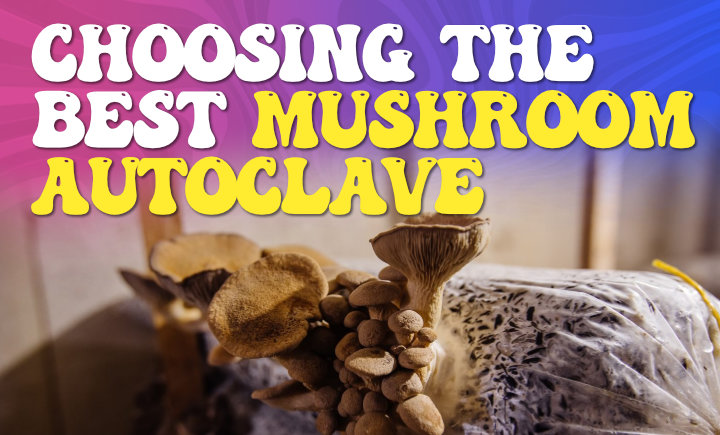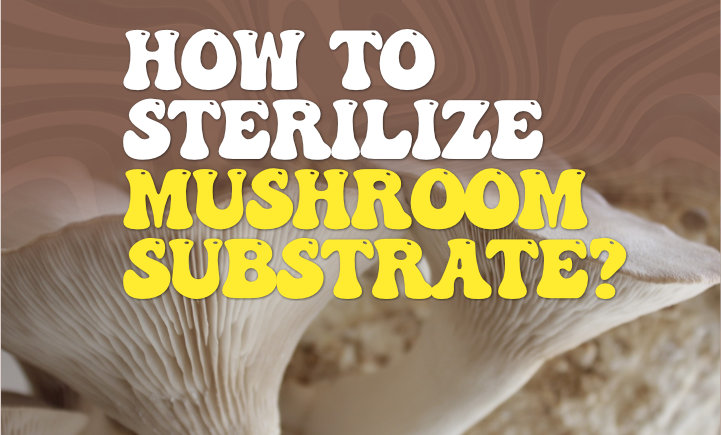Choosing The Best Mushroom Autoclave: 2024 Reviews And Buying Guide

Choosing the best mushroom autoclave is a crucial decision for mushroom cultivators who aim to create optimal conditions for their cultivation process. With numerous options available in the market, it’s essential to understand the key factors that determine the suitability of an autoclave for mushroom cultivation. Choosing The Best Mushroom
Autoclaves are specialized equipment designed to sterilize materials by subjecting them to high-pressure steam. In mushroom cultivation, autoclaves play a vital role in eliminating contaminants from substrate materials such as sawdust or straw before inoculation with mushroom spawn. To ensure successful cultivation, factors such as size, capacity, temperature control, and durability must be carefully considered when choosing a mushroom autoclave.
Here, we will provide valuable insights into selecting the best mushroom autoclave for achieving optimum results in mushroom cultivation processes.
Understanding Mushroom Autoclaves
Autoclaves are specialized pressure cookers that play a vital role in mushroom cultivation as they sterilize the mushroom substrate. The substrate refers to the material mushrooms grow, such as sawdust or straw. To achieve optimal conditions for mushroom growth, it’s important to eliminate any potential contaminants from the substrate. This is where autoclaves come into play, acting as steam sterilizers or mushroom sterilizers.
Autoclaves are designed to create an environment of high temperature and pressure within a sealed chamber, effectively killing bacteria, fungi, viruses, and other microorganisms in the substrate. By subjecting the substrate to these harsh conditions through steam sterilization, autoclaves ensure that only desired fungi species can thrive in the growing medium. Additionally, autoclave usage minimizes the risk of crop failure due to contamination.
When selecting an autoclave for mushroom cultivation, it is crucial to consider specific factors such as size capacity and ease of use. Different systems may have varying features like programmable settings or automatic controls that enhance productivity and efficiency during sterilization cycles. Furthermore, acquiring a reliable autoclave guarantees consistent results in terms of sterility while also reducing operational costs associated with failed crops.
Factors to Consider When Choosing a Mushroom Autoclave
One important factor to consider when selecting an autoclave for mushroom cultivation is the size and capacity of the equipment. The size of the autoclave should be chosen based on the number of mushrooms to be sterilized at a time. It is crucial to have an autoclave that can accommodate the desired batch size, as overcrowding can lead to inadequate sterilization.
Additionally, considering the capacity of the mushroom autoclave ensures efficient use of resources and reduces operating costs.
Another significant aspect is the type of sterilizer used in the mushroom autoclave. Autoclaves typically utilize pressure steam for sterilization purposes. This high-pressure steam effectively kills bacteria, viruses, and other microorganisms on mushroom substrates or growing media. Stainless steel chambers are commonly preferred due to their durability, corrosion resistance, and ease of cleaning. A stainless steel construction ensures a longer lifespan for your mushroom autoclave and minimizes maintenance requirements.
Furthermore, it is essential to evaluate the warranty offered by different manufacturers when choosing a mushroom autoclave. A comprehensive warranty provides peace of mind and safeguards against potential malfunctions or defects in manufacturing. Additionally, it indicates that the manufacturer has confidence in their product’s quality and performance.
Best Mushroom Autoclave for Mushroom Cultivation: Reviews and Recommendations
A top-tier pressure sterilizer is key to spawning success. These machines operate at high pressure and temperature levels, ensuring thorough sterilization within a relatively short time – typically 15-20 minutes, depending on capacity and model. Here are some leading contenders for the best mushroom autoclaves:
– All American Electric Sterilizer 75X – Known for its reliable performance and durability, this model offers precise control over sterilization time.
– Tuttnauer 3870M Manual Autoclave – This high-capacity autoclave is perfect for large-scale cultivators who require regular batch processing.
– Market Forge Sterilmatic STM-E – Featuring an automatic timer and temperature controls, this machine ensures consistent results every time.
– Zgood Autoclave Sterilizer – This compact yet powerful sterilizer is ideal for those with limited space but still demand high-quality output.
– BACOENG Food Grade Super-C Mini Autoclave – As an affordable option, it delivers impressive results thanks to its quick heating capability and solid construction.
How to Sterilize Mushroom Substrate?
To ensure the successful growth of mushrooms, it is imperative to employ an effective sterilization method for the mushroom substrate. One highly recommended method is using a mushroom autoclave.
A mushroom autoclave is a specialized piece of equipment designed to sterilize substrates such as sawdust or grain spawn by subjecting them to high pressure and steam. This process eliminates any potential contaminants that could hinder the growth of mushrooms.
When using a mushroom autoclave, it is important to follow proper procedures to achieve optimal results. Firstly, the substrate should be prepared by mixing it with water and placing it in suitable containers such as jars or bags. These containers should then be tightly sealed to prevent any contamination during the sterilization process.
Secondly, the substrate-filled containers are placed inside the mushroom autoclave, which is set at specific temperature and pressure settings. The high-pressure steam generated within the autoclave ensures thorough sterilization of the substrate.
The use of a vertical autoclave is particularly advantageous when sterilizing mushroom substrates. This type of autoclave allows for the even distribution of heat and steam throughout the container, ensuring uniform sterilization. Additionally, its vertical design allows for efficient stacking of containers, maximizing space utilization during large-scale cultivation operations.
How to Pasteurize Mushroom Substrate?
Pasteurizing mushroom substrate is a common method utilized in the mushroom farming industry to eliminate contaminants and promote the growth of healthy mushrooms. This process involves heating the substrate to a specific temperature range that effectively kills off unwanted microorganisms while preserving beneficial ones.
The goal of pasteurization is to create an environment conducive to mycelium colonization and subsequent mushroom formation.
The first step in pasteurizing mushroom substrate is preparing the material itself. Mushroom farms typically use organic materials such as straw, wood chips, or sawdust as the base for their substrates. These materials are often mixed with water and other supplements like gypsum or calcium carbonate before being placed in containers. Afterward, the containers are sealed tightly to create a controlled environment for pasteurization.
The next crucial stage is applying heat to the substrate. Pasteurization typically involves exposing the material to temperatures ranging between 140°F (60°C) and 160°F (71°C) for a specific duration, usually around one hour. This temperature range effectively eliminates many common contaminants while minimizing damage to spores or mycelium present within the substrate.
DIY Autoclave: Is It a Viable Option?
Constructing a DIY autoclave can be a viable option for individuals looking for a cost-effective solution to sterilize mushroom substrates. However, it requires careful planning, adherence to safety guidelines, and knowledge of proper sterilization cycles. If you’re considering building your autoclave, you must thoroughly research design considerations and safety precautions before starting the project. Alternatively, you may also consider referring to buying guides that provide detailed information on commercially available mushroom autoclaves to make an informed decision based on your specific needs.
Pasteurization vs. Sterilization: Which Method Should You Choose?
Both pasteurization and sterilization techniques are commonly used in mushroom cultivation to eliminate unwanted microorganisms and create a favorable environment for the growth of mushroom spawn.
Pasteurization involves heating the substrate at a lower temperature, typically around 140-160°F (60-71°C), for a longer duration, usually several hours. This method is effective in killing many bacteria, fungi, and other microorganisms while preserving some beneficial organisms that help in mushroom growth.
On the other hand, sterilization involves subjecting the substrate to higher temperatures, often achieved using an autoclave or pressure cooker. The process eliminates all forms of microbial life in the substrate, including spores and heat-resistant bacteria. Sterilization is considered more thorough than pasteurization but requires careful monitoring of temperature and pressure to avoid damaging the substrate or introducing contamination during cooling.
The choice between pasteurization and sterilization depends on various factors such as the type of mushroom being cultivated, available resources, desired yield, and level of risk tolerance for contamination.
Pasteurization is commonly used for substrates like straw or wood-based materials since these can be sensitive to high temperatures. It is also favored when cultivating certain types of mushrooms that require specific microorganisms present in unpasteurized materials.
On the other hand, when working with laboratory-grade agar or grain spawn where sterility is crucial, sterilization through an autoclave or grain sterilizer may be preferred.
Sterilizing Grain Spawn: Best Practices and Methods
Sterilizing grain spawn effectively eliminates all microbial life and is crucial for maintaining a sterile environment in laboratory-grade materials.
Grain spawn, which refers to the substrate on which mushroom spores are grown, plays a vital role in the cultivation process. By sterilizing the grain spawn, any potential contaminants are eradicated, ensuring that only the desired mushroom spores will grow. This step is particularly important when working with liquid culture or cultivating sensitive species such as oyster mushrooms.
One of the most commonly used methods for sterilizing grain spawns is through the use of an autoclave. Autoclaves provide consistent results by subjecting the material to specific temperature and pressure conditions for a predetermined period of time. This method ensures that all stages of microbial life are eliminated, from vegetative cells to highly resistant bacterial endospores.
Adhering to best practices in packaging and selecting appropriate autoclave settings further enhances the effectiveness of this method. By following these guidelines, cultivators can create an ideal environment for mushroom spores to thrive and propagate oyster mushrooms or other desired species.
Pressure Sterilizer for Mushroom Cultivation: An Alternative to Autoclaves
Pressure sterilizers offer an alternative method for achieving effective microbial elimination in mushroom cultivation, making them a valuable tool in the process. While autoclaves are commonly used for sterilizing equipment and materials in mushroom cultivation, pressure sterilizers provide a more cost-effective option without compromising quality. These devices use high pressure and heat to eliminate harmful microorganisms, ensuring a clean and sterile environment for mushroom growth.
Here are three key advantages of using pressure sterilizers in mushroom cultivation:
1. Cost-effectiveness: Pressure sterilizers offer a more affordable option than traditional autoclaves. They are often smaller in size and require less energy consumption, resulting in lower operational costs. This makes them an attractive choice for small-scale mushroom cultivators or those on a limited budget.
2. Fruiting potential: Pressure sterilization ensures that the growing medium is free from any contaminants that could hinder fruiting. By eliminating harmful bacteria and fungi, mushrooms have a better chance of developing healthy mycelium networks and producing abundant fruit bodies. This leads to higher yields and overall success in mushroom cultivation.
Pressure sterilizers provide an excellent alternative to autoclaves for achieving effective microbial elimination in mushroom cultivation. With their cost-effectiveness, ability to promote fruiting potential and wide-ranging applications beyond just mushrooms, these devices are becoming increasingly popular among cultivators worldwide.
Final Thoughts
Selecting the right mushroom autoclave or alternative method is crucial for successful mushroom cultivation. By considering the factors discussed in this guide and conducting thorough research based on your specific needs, you can make an informed decision that will contribute to a thriving mushroom-growing project.
Frequently Asked Questions
How do you autoclave mushroom substrate?
To autoclave mushroom substrate, it is typically placed in a heat-resistant bag or container and then subjected to high-pressure steam in an autoclave for a specific duration to kill any microorganisms.
What is the best sterilizer for mushroom cultivation?
The best sterilizer for mushroom cultivation is an autoclave due to its ability to kill a wide range of contaminants effectively.
What are the mushroom sterilization techniques?
Mushroom sterilization techniques include autoclaving, pressure cooking, and pasteurization.
What temperature do you sterilize mushrooms?
The temperature for sterilizing mushrooms typically ranges from 121 to 140 degrees Celsius (250 to 284 degrees Fahrenheit).
How long does it take to sterilize grain in an autoclave?
The time required to sterilize grain in an autoclave can vary, but it usually takes around 60 to 120 minutes.
Can fungi survive autoclaving?
Fungi cannot survive autoclaving as the high pressure and temperature effectively kill them.
What temperature do you sterilize in an autoclave?
The temperature for sterilization in an autoclave is usually around 121 degrees Celsius (250 degrees Fahrenheit) or higher.
How long do items remain sterile after autoclaving?
The items remain sterile after autoclaving as long as they are stored in a clean, closed, and sterile environment. However, the duration of sterility can vary depending on the conditions and handling of the items.


